engine coolant FORD MUSTANG 2000 4.G User Guide
[x] Cancel search | Manufacturer: FORD, Model Year: 2000, Model line: MUSTANG, Model: FORD MUSTANG 2000 4.GPages: 224, PDF Size: 1.86 MB
Page 145 of 224
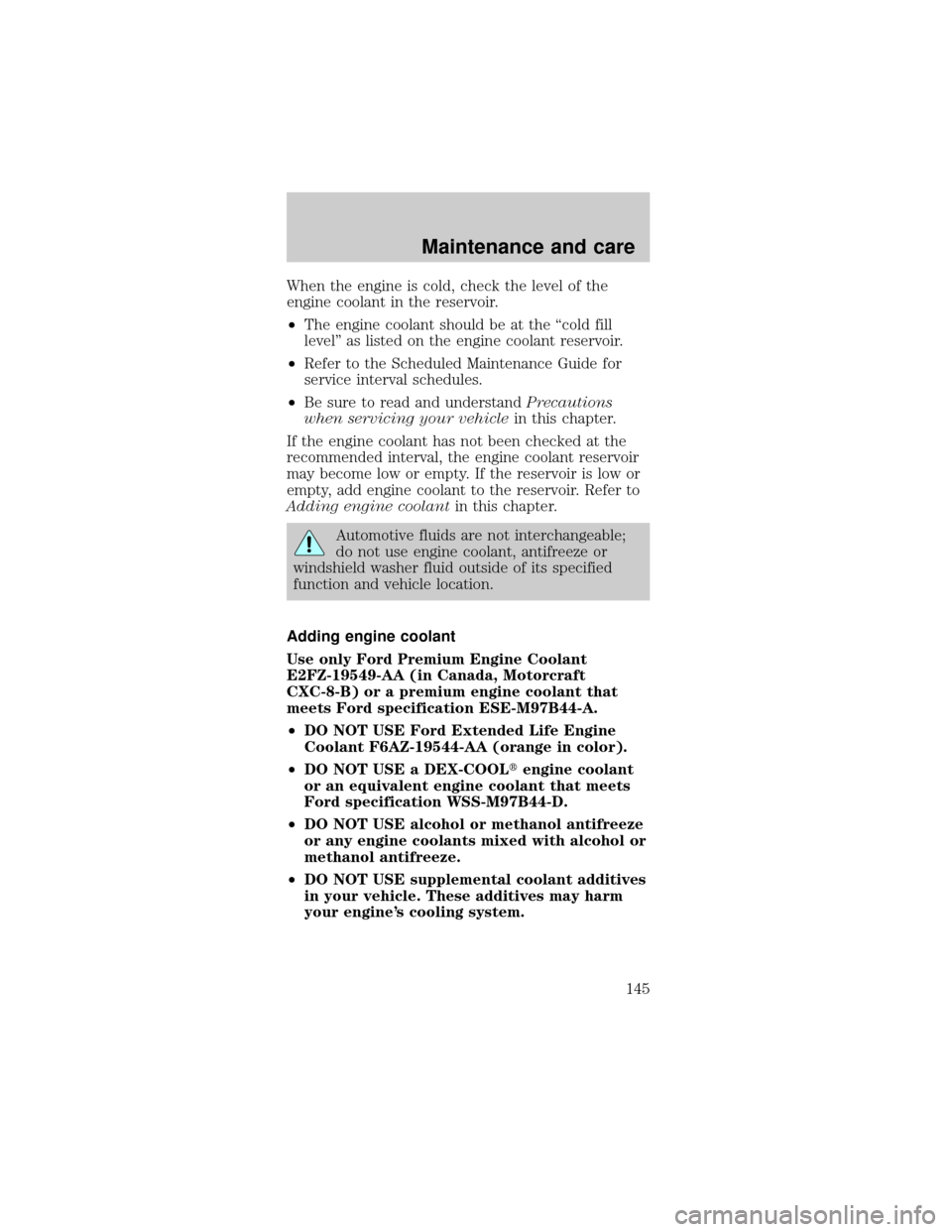
When the engine is cold, check the level of the
engine coolant in the reservoir.
²The engine coolant should be at the ªcold fill
levelº as listed on the engine coolant reservoir.
²Refer to the Scheduled Maintenance Guide for
service interval schedules.
²Be sure to read and understandPrecautions
when servicing your vehiclein this chapter.
If the engine coolant has not been checked at the
recommended interval, the engine coolant reservoir
may become low or empty. If the reservoir is low or
empty, add engine coolant to the reservoir. Refer to
Adding engine coolantin this chapter.
Automotive fluids are not interchangeable;
do not use engine coolant, antifreeze or
windshield washer fluid outside of its specified
function and vehicle location.
Adding engine coolant
Use only Ford Premium Engine Coolant
E2FZ-19549-AA (in Canada, Motorcraft
CXC-8-B) or a premium engine coolant that
meets Ford specification ESE-M97B44-A.
²DO NOT USE Ford Extended Life Engine
Coolant F6AZ-19544-AA (orange in color).
²DO NOT USE a DEX-COOLtengine coolant
or an equivalent engine coolant that meets
Ford specification WSS-M97B44-D.
²DO NOT USE alcohol or methanol antifreeze
or any engine coolants mixed with alcohol or
methanol antifreeze.
²DO NOT USE supplemental coolant additives
in your vehicle. These additives may harm
your engine's cooling system.
Maintenance and care
145
Page 146 of 224
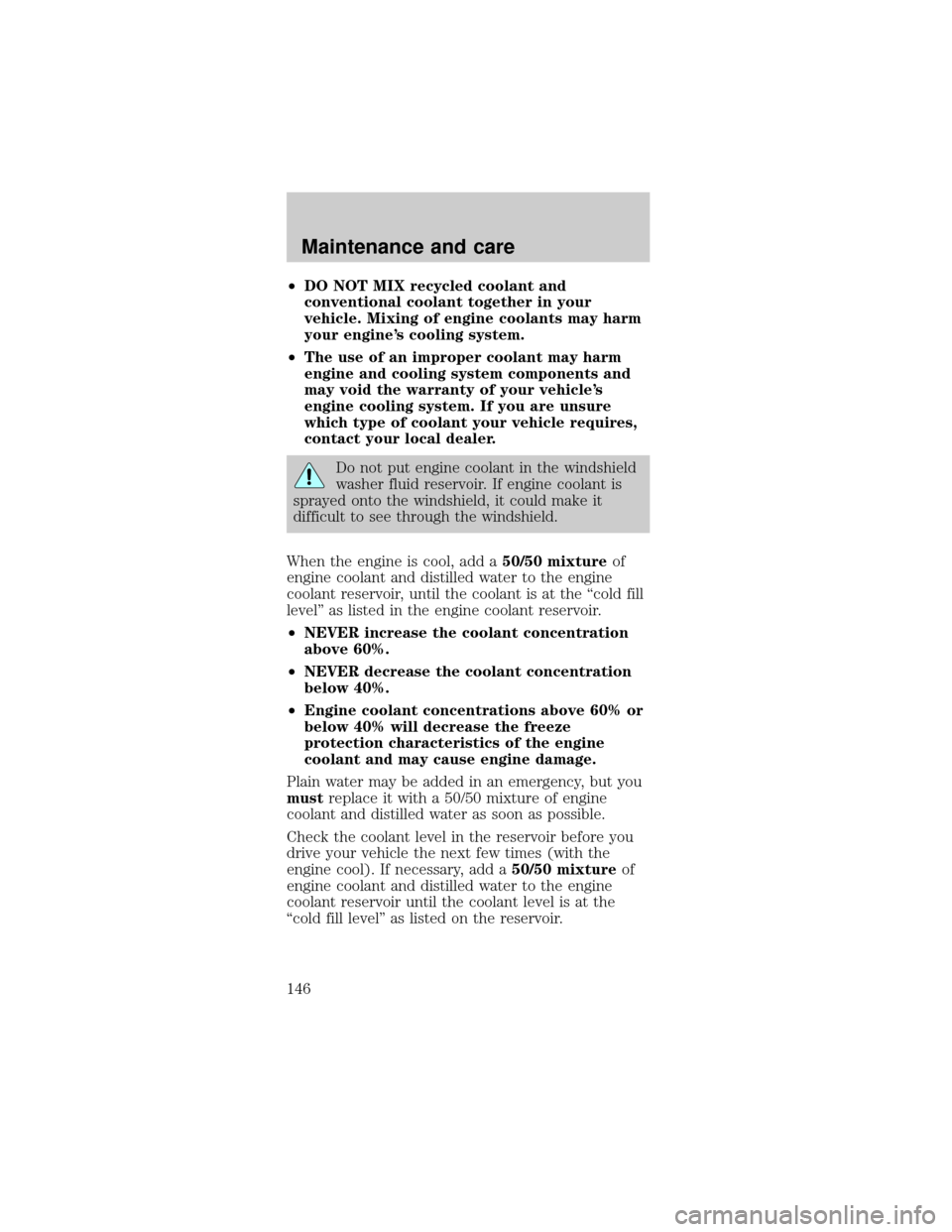
²DO NOT MIX recycled coolant and
conventional coolant together in your
vehicle. Mixing of engine coolants may harm
your engine's cooling system.
²The use of an improper coolant may harm
engine and cooling system components and
may void the warranty of your vehicle's
engine cooling system. If you are unsure
which type of coolant your vehicle requires,
contact your local dealer.
Do not put engine coolant in the windshield
washer fluid reservoir. If engine coolant is
sprayed onto the windshield, it could make it
difficult to see through the windshield.
When the engine is cool, add a50/50 mixtureof
engine coolant and distilled water to the engine
coolant reservoir, until the coolant is at the ªcold fill
levelº as listed in the engine coolant reservoir.
²NEVER increase the coolant concentration
above 60%.
²NEVER decrease the coolant concentration
below 40%.
²Engine coolant concentrations above 60% or
below 40% will decrease the freeze
protection characteristics of the engine
coolant and may cause engine damage.
Plain water may be added in an emergency, but you
mustreplace it with a 50/50 mixture of engine
coolant and distilled water as soon as possible.
Check the coolant level in the reservoir before you
drive your vehicle the next few times (with the
engine cool). If necessary, add a50/50 mixtureof
engine coolant and distilled water to the engine
coolant reservoir until the coolant level is at the
ªcold fill levelº as listed on the reservoir.
Maintenance and care
146
Page 147 of 224
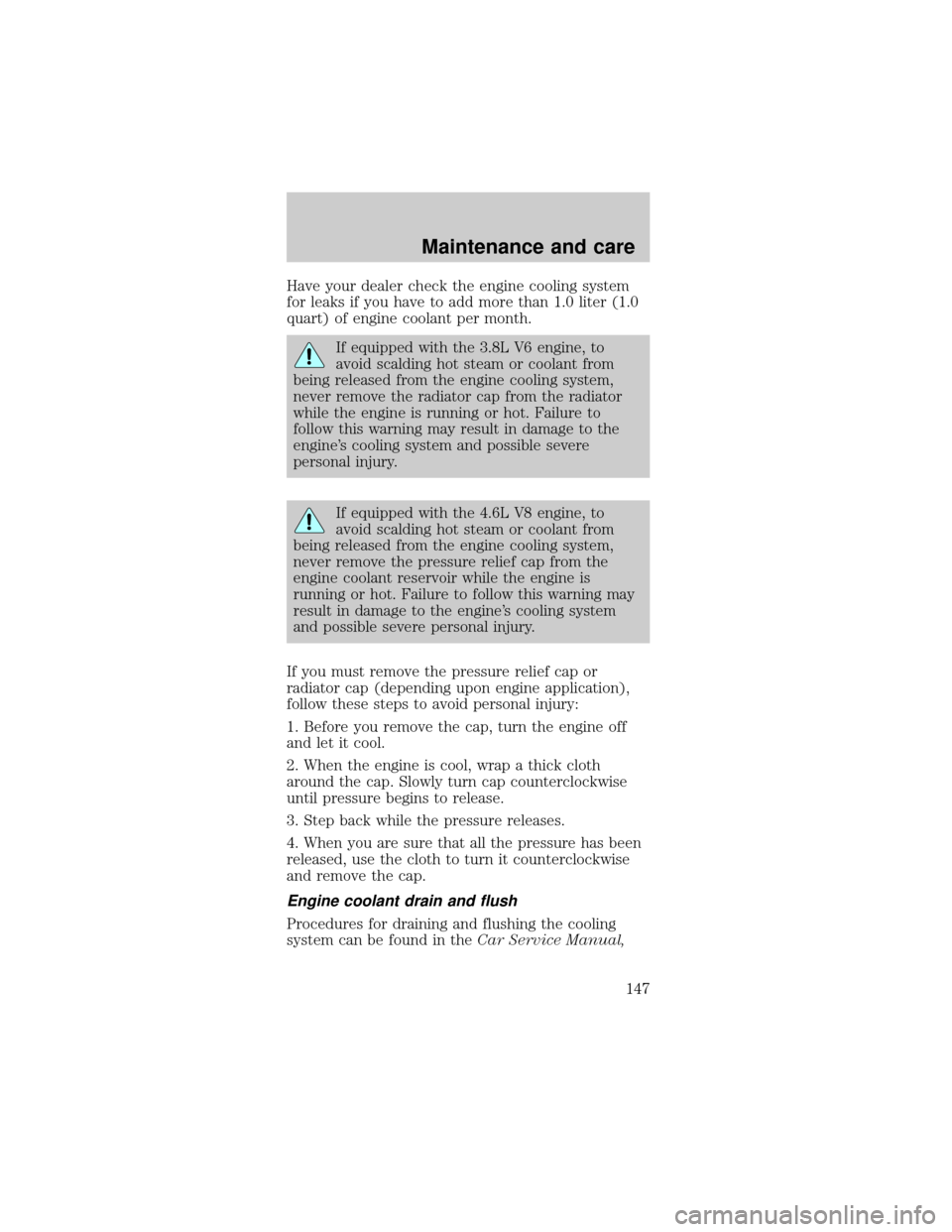
Have your dealer check the engine cooling system
for leaks if you have to add more than 1.0 liter (1.0
quart) of engine coolant per month.
If equipped with the 3.8L V6 engine, to
avoid scalding hot steam or coolant from
being released from the engine cooling system,
never remove the radiator cap from the radiator
while the engine is running or hot. Failure to
follow this warning may result in damage to the
engine's cooling system and possible severe
personal injury.
If equipped with the 4.6L V8 engine, to
avoid scalding hot steam or coolant from
being released from the engine cooling system,
never remove the pressure relief cap from the
engine coolant reservoir while the engine is
running or hot. Failure to follow this warning may
result in damage to the engine's cooling system
and possible severe personal injury.
If you must remove the pressure relief cap or
radiator cap (depending upon engine application),
follow these steps to avoid personal injury:
1. Before you remove the cap, turn the engine off
and let it cool.
2. When the engine is cool, wrap a thick cloth
around the cap. Slowly turn cap counterclockwise
until pressure begins to release.
3. Step back while the pressure releases.
4. When you are sure that all the pressure has been
released, use the cloth to turn it counterclockwise
and remove the cap.
Engine coolant drain and flush
Procedures for draining and flushing the cooling
system can be found in theCar Service Manual,
Maintenance and care
147
Page 148 of 224

which can be purchased from your dealer.
Engine coolant refill procedure-3.8L V6 engine
Use the following procedure when refilling
the cooling system of a vehicle equipped
with a 3.8L V6 engine. Failure to follow this
warning may result in damage to the engine and
engine cooling system.
The following procedure should be used when
refilling the cooling system of a 3.8L V6 engine after
it has been drained or become extremely low.
1. Remove the cap
from the engine
coolant reservoir.
2. Open the cooling
system vent plug.
3. Remove the radiator
cap as previously
outlined.
4. Add a50/50 mixtureof engine coolant and
distilled water to the radiator until full.
5. Add a50/50 mixtureof engine coolant and
distilled water to the engine coolant reservoir until
the coolant level is at the ªcold fill levelº as listed on
the reservoir.
6. Close the cooling system vent plug.
7. Reinstall the engine coolant reservoir cap.
8. Reinstall the radiator cap.
9. Start and idle the engine until the upper radiator
hose is warm (this indicates the thermostat is open
and coolant is flowing through the entire system).
10. Immediately shut the engine off.
11. Wrap a thick cloth around the radiator cap and
cautiously remove the radiator cap.
2
31
Maintenance and care
148
Page 149 of 224

12. Add a50/50 mixtureof engine coolant and
distilled water to the radiator until full.
13. Reinstall the radiator cap.
14. Check the coolant level in the reservoir before
you drive your vehicle the next few times (with the
engine cool).
15. If necessary, add a50/50 mixtureof engine
coolant and distilled water to the engine coolant
reservoir until the coolant level is at the ªcold fill
levelº as listed on the reservoir.
If you are unsure of how to operate the cooling
system vent plug when adding engine coolant to the
3.8L V6 engine, contact your dealer.
Engine coolant refill procedure-4.6L V8 engine
The following procedure should be used when
refilling the cooling system of a 4.6L V8 engine after
it has been drained or become extremely low.
1. Remove the pressure relief cap from the engine
coolant reservoir as previously outlined.
2. Slowly add a50/50 mixtureof engine coolant
and distilled water to the engine coolant reservoir
until the coolant level is at the ªcold fill levelº as
listed on the reservoir.
3. Reinstall the pressure relief cap.
4. Start and idle the engine until the upper radiator
hose is warm (this indicates the thermostat is open
and coolant is flowing through the entire system).
5. Shut the engine off and let it cool.
6. Remove the pressure relief cap from the engine
coolant reservoir as previously outlined.
7. Add a50/50 mixtureof engine coolant and
distilled water to the engine coolant reservoir until
the coolant level is at the ªcold fill levelº as listed on
the reservoir.
8. Reinstall the pressure relief cap.
Maintenance and care
149
Page 150 of 224
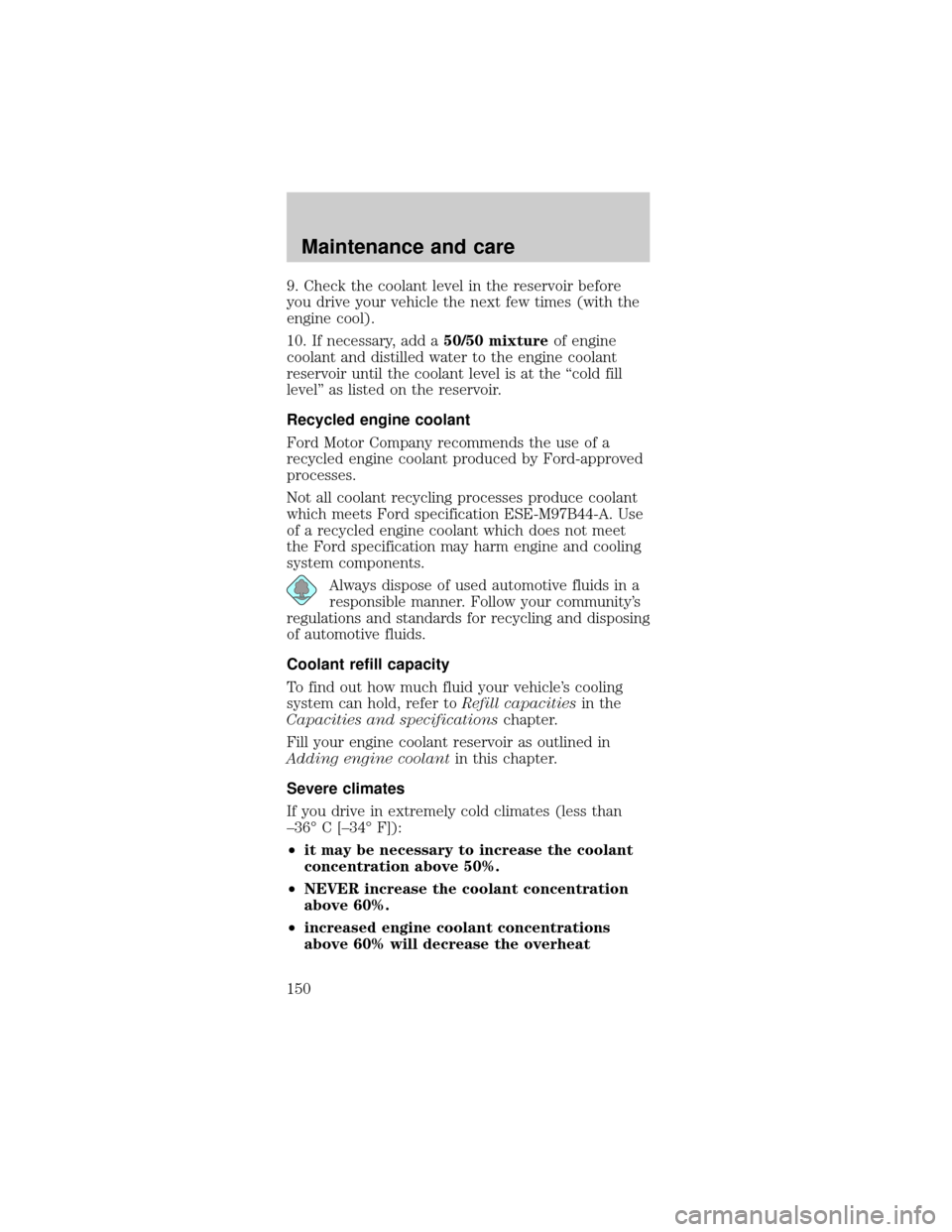
9. Check the coolant level in the reservoir before
you drive your vehicle the next few times (with the
engine cool).
10. If necessary, add a50/50 mixtureof engine
coolant and distilled water to the engine coolant
reservoir until the coolant level is at the ªcold fill
levelº as listed on the reservoir.
Recycled engine coolant
Ford Motor Company recommends the use of a
recycled engine coolant produced by Ford-approved
processes.
Not all coolant recycling processes produce coolant
which meets Ford specification ESE-M97B44-A. Use
of a recycled engine coolant which does not meet
the Ford specification may harm engine and cooling
system components.
Always dispose of used automotive fluids in a
responsible manner. Follow your community's
regulations and standards for recycling and disposing
of automotive fluids.
Coolant refill capacity
To find out how much fluid your vehicle's cooling
system can hold, refer toRefill capacitiesin the
Capacities and specificationschapter.
Fill your engine coolant reservoir as outlined in
Adding engine coolantin this chapter.
Severe climates
If you drive in extremely cold climates (less than
±36É C [±34É F]):
²it may be necessary to increase the coolant
concentration above 50%.
²NEVER increase the coolant concentration
above 60%.
²increased engine coolant concentrations
above 60% will decrease the overheat
Maintenance and care
150
Page 151 of 224

protection characteristics of the engine
coolant and may cause engine damage.
²refer to the chart on the coolant container
to ensure the coolant concentration in your
vehicle will provide adequate freeze
protection at the temperatures in which you
drive in the winter months.
If you drive in extremely hot climates:
²it is still necessary to maintain the coolant
concentration above 40%.
²NEVER decrease the coolant concentration
below 40%.
²decreased engine coolant concentrations
below 40% will decrease the corrosion
protection characteristics of the engine
coolant and may cause engine damage.
²decreased engine coolant concentrations
below 40% will decrease the freeze
protection characteristics of the engine
coolant and may cause engine damage.
²refer to the chart on the coolant container
to ensure the coolant concentration in your
vehicle will provide adequate protection at
the temperatures in which you drive.
Vehicles driven year-round in non-extreme climates
should use a 50/50 mixture of engine coolant and
distilled water for optimum cooling system and
engine protection.
CHECKING AND ADDING POWER STEERING
FLUID
Check the power steering fluid. Refer to the
Scheduled Maintenance Guide for the service
interval schedules. If adding fluid is necessary, use
only MERCONtAT F.
Maintenance and care
151
Page 152 of 224
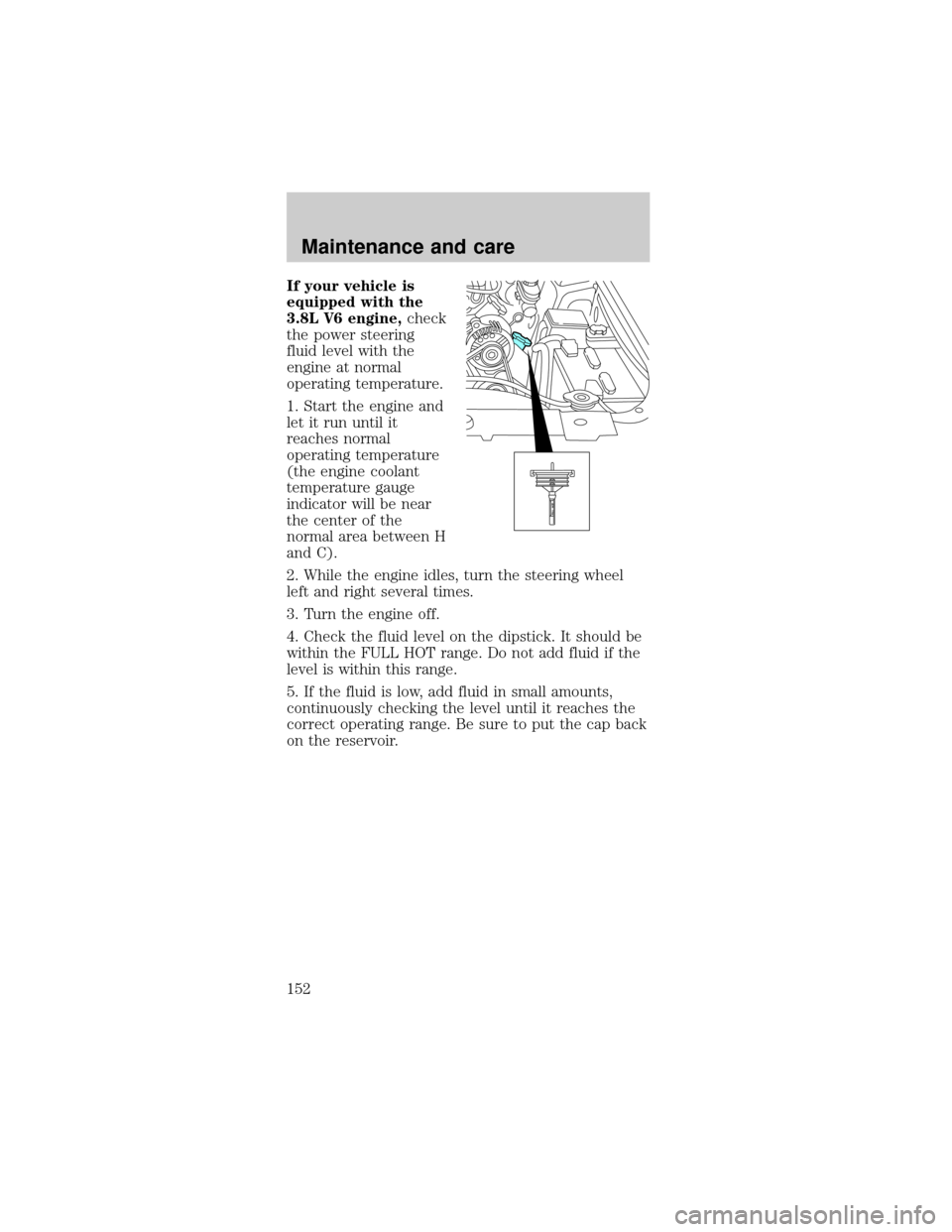
If your vehicle is
equipped with the
3.8L V6 engine,check
the power steering
fluid level with the
engine at normal
operating temperature.
1. Start the engine and
let it run until it
reaches normal
operating temperature
(the engine coolant
temperature gauge
indicator will be near
the center of the
normal area between H
and C).
2. While the engine idles, turn the steering wheel
left and right several times.
3. Turn the engine off.
4. Check the fluid level on the dipstick. It should be
within the FULL HOT range. Do not add fluid if the
level is within this range.
5. If the fluid is low, add fluid in small amounts,
continuously checking the level until it reaches the
correct operating range. Be sure to put the cap back
on the reservoir.
FILL
HOT
Maintenance and care
152
Page 191 of 224

MOTORCRAFT PART NUMBERS
Component 3.8L OHV V6 engine 4.6L SOHC V8 engine
Air filter element FA-1611 FA-1634
Fuel filter FG-800AFG-986 FG-800AFG-986
Battery BXT-59 BXT-59
Oil filter FL-400S FL-820S
PCV valve EV-152 EV-98
Spark plugs* AWSF-42EE** AWSF-32P
* Refer to Vehicle Emissions Control Information (VECI) decal for
spark plug gap information.
**If a spark plug is removed for inspection, it must be reinstalled in
the same cylinder. If a spark plug needs to be replaced, use only spark
plugs with the same service part number suffix letter as shown on the
engine decal.
REFILL CAPACITIES
Fluid Ford Part Name Application Capacity
Brake fluid High Performance
DOT 3 Motor
Vehicle Brake
FluidAll Fill to line on
reservoir
Engine oil
(includes filter
change)Motorcraft SAE
5W-30 Super
Premium Motor
OilAll 4.7L (5.0 quarts)
Engine coolant
1Premium Engine
Coolant3.8L OHV V6
engine11.2L
(11.8 quarts)
4.6L SOHC V8
engine13.3L
(14.1 quarts)
Power steering
fluidMotorcraft
MERCONtAT F3.8L OHV V6
engineKeep in FULL
HOT range on
dispstick
4.6L SOHC V8
engineFill to between
MIN and MAX
lines on reservoir
Rear axle
lubricant
2Motorcraft SAE
80W-90 Premium
Rear Axle
Lubricant7.5 inch axle 1.5L (3.25 pints)
8.8 inch axle 1.7L (3.75 pints)
Fuel tank N/A All 59.4L
(15.7 gallons)
Capacities and specifications
191
Page 192 of 224
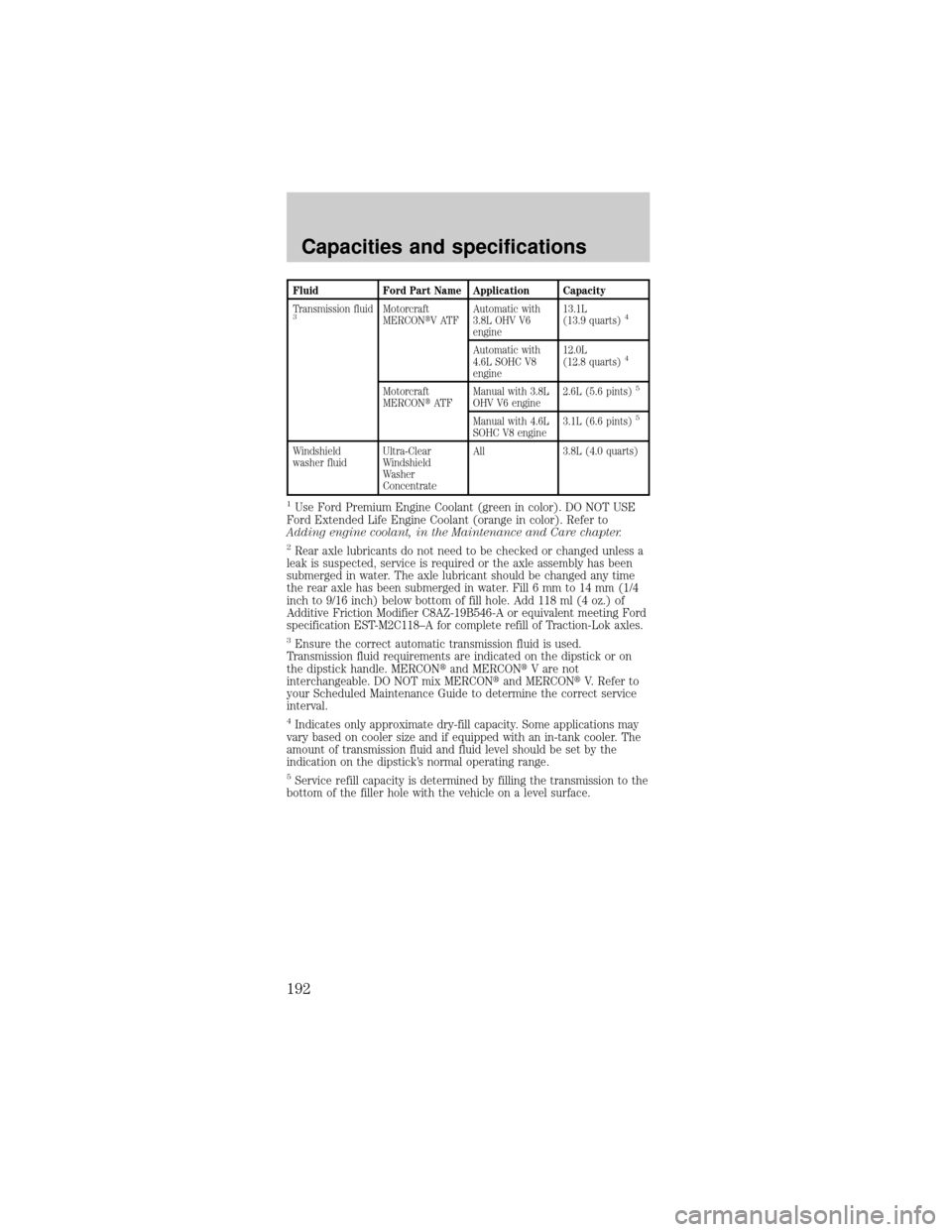
Fluid Ford Part Name Application Capacity
Transmission fluid
3Motorcraft
MERCONtVATFAutomatic with
3.8L OHV V6
engine13.1L
(13.9 quarts)4
Automatic with
4.6L SOHC V8
engine12.0L
(12.8 quarts)4
Motorcraft
MERCONtAT FManual with 3.8L
OHV V6 engine2.6L (5.6 pints)5
Manual with 4.6L
SOHC V8 engine3.1L (6.6 pints)5
Windshield
washer fluidUltra-Clear
Windshield
Washer
ConcentrateAll 3.8L (4.0 quarts)
1Use Ford Premium Engine Coolant (green in color). DO NOT USE
Ford Extended Life Engine Coolant (orange in color). Refer to
Adding engine coolant, in the Maintenance and Care chapter.
2Rear axle lubricants do not need to be checked or changed unless a
leak is suspected, service is required or the axle assembly has been
submerged in water. The axle lubricant should be changed any time
the rear axle has been submerged in water. Fill 6 mm to 14 mm (1/4
inch to 9/16 inch) below bottom of fill hole. Add 118 ml (4 oz.) of
Additive Friction Modifier C8AZ-19B546-A or equivalent meeting Ford
specification EST-M2C118±A for complete refill of Traction-Lok axles.
3Ensure the correct automatic transmission fluid is used.
Transmission fluid requirements are indicated on the dipstick or on
the dipstick handle. MERCONtand MERCONtV are not
interchangeable. DO NOT mix MERCONtand MERCONtV. Refer to
your Scheduled Maintenance Guide to determine the correct service
interval.
4Indicates only approximate dry-fill capacity. Some applications may
vary based on cooler size and if equipped with an in-tank cooler. The
amount of transmission fluid and fluid level should be set by the
indication on the dipstick's normal operating range.
5Service refill capacity is determined by filling the transmission to the
bottom of the filler hole with the vehicle on a level surface.
Capacities and specifications
192